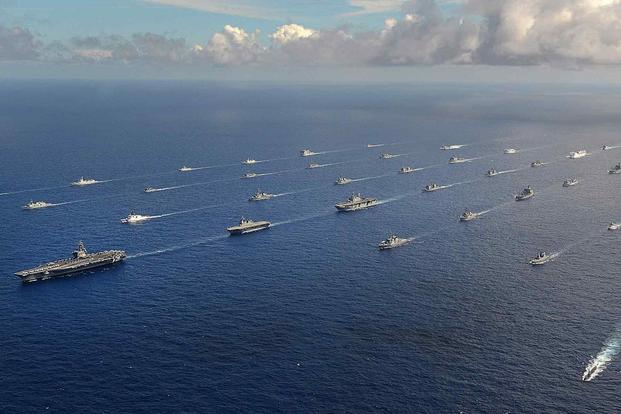Tens of thousands of sailors and Marines will participate in the biggest U.S. naval exercise in a generation to test how the services will fight across vast distances as they prepare for possible conflict with China or Russia.
Aircraft carriers, submarines, planes, unmanned vessels, and about 25,000 personnel will participate in Large Scale Exercise 2021, which will begin in late summer. The massive exercise will span 17 time zones with sailors and Marines in the U.S., Africa, Europe and the Pacific joining.
Live forces will participate in both the Atlantic and Pacific oceans.
"LSE is more than just training, it is leveraging the integrated fighting power of multiple naval forces to share sensors, weapons, and platforms across all domains in contested environments, globally," said Adm. Christopher Grady, commander of U.S. Fleet Forces, told Military.com in an email.
The exercise, he added, will be the first in a series "that will continue to push the envelope of what it means to be the superior maritime force."
Read Next: Super Hercules Crew Receives DFC, Air Medals for Daring Afghanistan Flight Under Fire
The Navy and Marine Corps are working more closely after decades of missions focused on the Middle East. As competition for influence builds with China and Russia, the Department of the Navy is shifting its focus from a largely land-based fight against terror groups to deterring aggression.
Three dozen units will participate in physical portions of the large-scale exercise, while more than 50 will join the exercise remotely, said Lt. Cmdr. Tabitha Klingensmith, with U.S. Fleet Forces Command. Participating units will include personnel from all three Marine expeditionary forces and sailors from the Navy's Second, Third, Sixth, Seventh and Tenth fleets.
While the U.S. has held big naval exercises like Bold Alligator and Rim of the Pacific, Klingensmith said the training events are growing in scope and complexity. Chief of Naval Operations Adm. Mike Gilday has referred to the upcoming large-scale exercise as the biggest naval training event in a generation.
That's because combining live and virtual participants "will expand the playing field beyond what has ever been achieved in live-only exercises," Klingensmith said.
"LSE 2021 will use technologies similar to what you see in virtual video gaming environments to expand the number of participants by linking commands and units around the globe virtually, thereby increasing the number of players, real and synthetic, to better replicate the realistic scale of scenarios the Navy and Marine Corps team is likely to face in the future," she added.
The sailors and Marines participating will test several concepts they're likely to encounter in a possible conflict with China. Scenarios will test the sailors and Marines' ability to conduct distributed operations; expeditionary advanced-base operations; littoral operations in a contested environment; and command and control in a contested environment.
"We've been applying warfighting concepts like Distributed Maritime Operations ... to fleet battle problems at the strike group level to rapidly advance organizational learning," Grady said. "LSE 2021 is important because we will apply those lessons learned at-scale to further our employment of synchronized, integrated operations across all domains globally, to ensure we remain the superior maritime force in a high-end fight."
The Navy and Marine Corps are finalizing details on the exercise, but Klingensmith said they plan to incorporate at least one unmanned platform -- the Autonomous Littoral Connector, a surface vessel that can provide logistics support from shore to ship.
That's traditionally a Navy mission, she said, but during the exercise it'll be under the command and control of the Marine Corps. The 2021 updates to Commandant Gen. David Berger's Force Design plans for the Marine Corps call for that service to -- in partnership with the Navy -- explore developing "littoral maneuver groups" to operate the future light amphibious warship.
Editor's note: This story has been updated to correct the number of time zones involved in the exercise.
-- Gina Harkins can be reached at gina.harkins@military.com. Follow her on Twitter @ginaaharkins.
Related: Marines Hop Islands, Set Up Long-Range Fires as Force Preps for Clash with China












